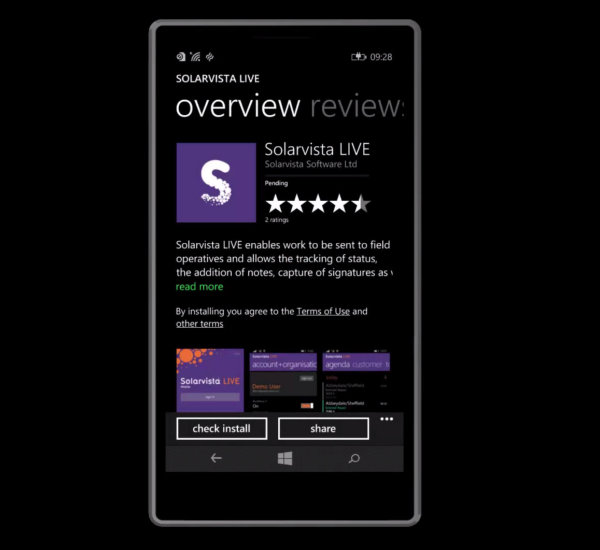Why independent field service software & mobile specialist means best-of-breed?
At Solarvista we’re fiercely proud to deliver the very best in field service management software and it is our independence that enables us to...
A ready-made field service management system suitable for various workflows.
A 'No-code' Application Platform enabling custom applications or hybrid solutions.
Expertise to help accelerate your project and get the most from it.

The BYOD (“Bring Your Own Device”) debate is one that has received much coverage in recent months with some in the service sector as well as other industries arguing that BYOD is the only way forward for businesses looking to compete effectively and offer the most efficient customer service and increased employee satisfaction. But what is BYOD? What is the impact on the business, the workers, and the customers?
A complete move to BYOD is not going to be right for every business in every service sector, but a lot of businesses may already be partaking in some kind of BYOD scheme without even realising. For example, if employees have access to company emails on their personal mobile phone or tablet or another device then this is, in effect, BYOD. In fact research has found that globally 60% of full-time employees use BYOD to some extent. (Gabriel, 2013)
So what actually is BYOD?
Simply, “Bring Your Own Device” refers to employees having the ability to connect their own technical devices such as smart phones, laptops and tablets to the company’s network instead of using a device owned by the company. Recent years have seen an influx of workers bringing their own personal devices into their work environment and using them in their everyday jobs (Millard, 2011). In fact, 95% of employees have used their own device in work (Gens et al, 2013) and the majority already use their own personal device for a variety of work-related tasks, including communication, content creation and admin (Ellis et al, 2012).
What are the advantages and disadvantages?
There are a number of advantages to BYOD for both the user of the device and the company employing that user. However, the other side of the debate – the potential pitfalls that a company may face because of BYOD – tend to be less obvious. Below are some examples, but not an exhaustive list, both from the user and business perspective.
Advantages
Disadvantages
58% of IT security and audit experts view employee-owned devices as a security risk to the enterprise.
Conclusion
BYOD represents the tipping point from corporate-led IT to consumer-driven IT; corporate IT now significantly lags behind the consumer market (Millard, 2011) and this has had a dramatic effect on the desire of employees to use their own devices at work. It is a trend that is set to continue throughout 2016 and beyond.
Over the last couple of years, these devices have become integrated into everyday life for most people as result of the ‘always on’ nature of social media and the 24/7 online world. With the lightning speed at which technology is progressing it is maybe neither cost-effective nor practical for businesses to update their employees’ technological devices as often as both the company and the employee might wish. Therefore, BYOD has become the natural solution to this problem.
However, there are a number of key considerations when implementing any kind of BYOD scheme in the workplace. Most notably these are around security; of your company’s data and networks, of access to your systems and around confidentiality. The use of industrial-strength security approaches, such as Microsoft’s Azure Active Directory, is important to deliver this with confidence.
One size increasingly doesn’t fit all in terms of tools and technologies for work. The challenge is for the IT department to ensure their business is secure.
Also, there are a number of functionality and cost implications worth noting. If you need particular functionality from your devices that is only available on expensive corporate hardware, then BYOD may not even be applicable at the moment. Here at Solarvista, our new line of cross-device mobile apps offers a good feature set but it will be mid-2015 before the sheer volume of functionality is available on all platforms. There are big challenges ahead in ensuring the business remains secure whilst also adopting working methods that are becoming ever more prevalent and popular. It is important to know that BYOD, according to the experts, isn’t going anywhere. Therefore there should be no rush to implement it without giving proper consideration to all the ways it will affect your business, your employees and ultimately your customers.
Solarvista are a leading provider of Service Management Software for Mobile Worers. Our constantly evolving products are available in three editions to meet the needs of your business large or small both now, and in the future. Read more about our Field Service Management Software Editions and arrange a free trial or contact us for more information or to discuss your requirements.

At Solarvista we’re fiercely proud to deliver the very best in field service management software and it is our independence that enables us to...

At Solarvista, we launched our first mobile app way back in 2002, called Mobile Worker. It was designed to operate as field service mobile...

Leading edge practitioners have long recognised that effective visible inventory management and stock control are very different from simple...